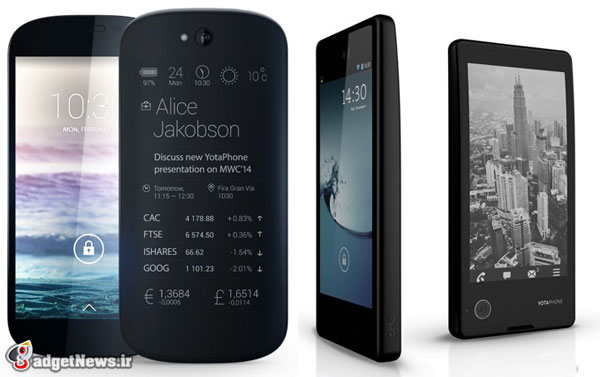
یکی از برترین و خلاقانهترین محصولات نمایشگاه امسال بارسلونا اسپانیا را میتوان تلفن با دو صفحه نمایش Yota نامید. تلفن هوشمندی که سال گذشته، با اشکالات ریز و درشت به نمایشگاه آمده بود، ولی امسال با برطرف کردن معایب قبلی، خود را برای حضور در بازار تلفنهای هوشمند آماده کرده است.
محصول جدید Yota با صفحه نمایش دوتایی، پنل E-link کاملا لمسی را به بدنه پشتی اضافه نموده است که میتواند توییتها، ایمیلها و پیغامهای شما را در صفحه نمایش 4.7 اینچی نمایش دهد و بدین ترتیب نیاز شما به استفاده از صفحه قدیمی و پرمصرف جلویی که تاکنون تنها نمایشگر محصولات دیجیتالی محسوب میشد را کاهش دهد.
اما این، تمامی بهبودهایی نیست که نسل جدید تلفنهای دو صفحه Yota تجربه میکند. از طرف دیگر، وقتی که تلفن را به سمت معمول نگاه میکنید، صفحه نمایش 5 اینچی از نوع AMOLED و با رزولوشن 1080p مواجه میشوید. در قلب دستگاه نیز، تراشه 800 Snapdragon با فرکانس کاری 2.3 گیگاهرتزی جایگزین Snapdragon 6o0 شده است و وظیفه پردازش اطلاعات مربوط به دو پنل لمسی را در ضخامتی به اندازه 8.9 میلیمتر دارد.
{photo}92/12/05/YotaPhone{/photo}
تنها اشکالی که میتواند ضربه بر پیکره این محصول نسل آینده باشد، عدم پشتیبانی از تمامی اپلیکیشنهای اندرویدی در پنل لمسی پشت آن است. پنلی که میتواند در اپلیکیشنهای امروزی نقش بسزایی داشته باشد و با مصرف کمتر از صفحه نمایش جلو، قابلیتهای کم کردن مصرف انرژی را نیز به همراه داشته باشد. در کل در استفاده از پنل لمسی پشت ناچارید به تعداد محدودتری از اپلیکیشنهای اندرویدی بسنده کنید. البته سازندگان Yota نیز که به اشکالات محصول خود واقف هستند، در پی حل این موضوع هستند. از جمله اقدامات آنها، باز گذاشتن SDK محصول خود برای تمامی توسعه دهندگان و گفت و گو با گوگل، آمازون و Barnes & Noble برای توسعه اپلیکیشنهایشان و سازگاری آنها، با پنل لمسی پشت تلفنهوشمند Yota است.
یوتا ایده بسیار جالب و کاربردی را ارایه کرده است، میزان قابل توجهای از شارژ باطری در تلفنهای هوشمند صرف نمایشگر در اموری مانند برقراری تماس، خواندن توییتها، مطالعه ایمیل و غیره میشود. تمام این امور از طریق صفحه نمایش بسیار کم مصرف E-INK پشت تلفن یوتا قابل انجام هستند با این تفاوت که در این حالت مصرف انرژی چندین برابر کمتر از زمانی خواهد بود که از صفحه نمایش جلوی دستگاه استفاده میکنید.
منبع : engadget
Dual-screen YotaPhone has a second shot at greatness
If you caught our review of the YotaPhone at the end of last year, you'll know we were cautious about recommending it — in fact, we said it was probably safer to hold out for a second-gen device. Well, here's a surprise: that replacement is already at the prototype stage and it brings some big improvements that could undo many of the criticisms we leveled at the original. Most importantly, the rear E-Ink panel is now fully touch sensitive, which means you'll be able to a lot more with this phone without ever needing to engage the traditional, power-hungry display on the other side. Calls, texts, emails, browsing, tweeting and more can be handled using the "always-on" 4.7-inch E-Ink display, with the only sacrifice being predictably slower refresh rates.
Although we've been hands-on with a very early and fragile prototype, the physical improvements are immediately obvious. When you turn the phone over to its "normal" side, for example to watch video or use the camera, you'll notice that the 720p LCD panel has been upgraded to a slightly bigger 5-inch, 1080p, AMOLED one. Android performance will also benefit from the inclusion of a 2.3GHz Snapdragon 800 instead of the old Snapdragon 600, and overall thickness has been reduced to 8.9mm (0.35 inches). Assuming that the price doesn't soar much higher than the original's 499 ($675), these are all very welcome changes.
Unfortunately, it sounds like you still won't be able to run the whole of Android (and all Android apps) on the E Ink side, despite the addition of full touch sensitivity. That's a shame, because there are literally thousands of mainstream apps that could be put to good use in low-power mode (not least major e-book readers and music streamers). However, Yota Devices has a plan: It's making its SDK open to everybody today, which should make it easier for developers to tweak their code to support the rear panel, and it says it's still in talks with Google, Amazon and Barnes & Noble to make all those apps compatible. So, who knows? If they can get some of this support in place by the time this next-gen YotaPhone launches later in the year, we could be looking a drastically superior product.
 گجت نیوز آخرین اخبار تکنولوژی، علم و خودرو
گجت نیوز آخرین اخبار تکنولوژی، علم و خودرو 





